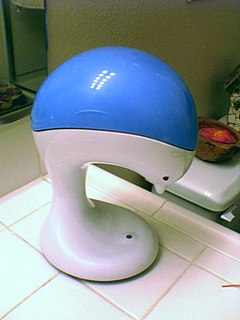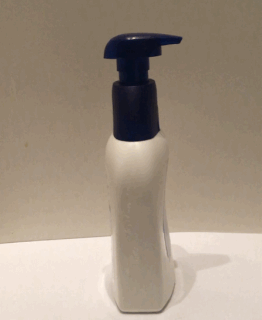 W
WSoap is a salt of a fatty acid used in a variety of cleansing and lubricating products. In a domestic setting, soaps are surfactants usually used for washing, bathing, and other types of housekeeping. In industrial settings, soaps are used as thickeners, components of some lubricants, and precursors to catalysts.
 W
WAfrican black soap, or black soap, is a kind of soap originating in West Africa. It is made from the ash of locally harvested African plants and dried peels, which gives the soap its characteristic dark colour. Black soap has become a popular toiletry product in North America due to its benefits on oily and acne-prone skin. In West Africa, especially Ghana, black soap is often made by women using traditional recipes and is often exported through fair trade groups.
 W
WAleppo soap is a handmade, hard bar soap associated with the city of Aleppo, Syria. Aleppo soap is classified as a Castile soap as it is a hard soap made from olive oil and lye, from which it is distinguished by the inclusion of laurel oil.
 W
WAn amphiphile is a chemical compound possessing both hydrophilic and lipophilic (fat-loving) properties. Such a compound is called amphiphilic or amphipathic. This forms the basis for a number of areas of research in chemistry and biochemistry, notably that of lipid polymorphism. Organic compounds containing hydrophilic groups at both ends of a prolate molecule are called bolaamphiphilic. Common amphiphilic substances are soaps, detergents, and lipoproteins.
 W
WAntibacterial soap is a soap which contains chemical ingredients that purportedly assist in killing bacteria. The majority of antibacterial soaps contain triclosan, though other chemical additives are also common. The effectiveness of products branded as being antibacterial has been disputed by some academics as well as the U.S. Food and Drug Administration (FDA).
 W
WThe Soap Museum is a museum in Sidon specialized in Levantine soaps. It is open since 2000 and managed by the Audi Foundation.
 W
WAn automatic soap dispenser is a device that dispenses a controlled amount of soap solution. They are often used in conjunction with automatic faucets in public restrooms. They function to conserve the amount of soap used and stem infectious disease transmission.
 W
WAzul e branco, also known as sabão Offenbach, and sometimes as Sabão macaco, is a type of soap used in Portugal. It is comparable to household soap, but it has a rugged texture, bulky shape, lack of odour and can generally be purchased in many convenience stores and supermarkets. In Portuguese "azul e branco" literally means "blue and white", which are the distinctive colours of the soap. It can also be found in red and white.
 W
WCarbolic soap, sometimes referred to as red soap, is a mildly antiseptic soap containing carbolic acid and/or cresylic acid, both of which are phenols derived from either coal tar or petroleum sources.
 W
WCastile soap is a vegetable oil-based hard soap made in a style similar to that originating in the Castile region of Spain.
 W
WCuticura soap, manufactured by the Potter Drug and Chemical company, is an antibacterial medicated soap in use since 1865. Noted Boston philanthropist George Robert White (1847-1922) was once the president and owner of Potter Drug and Chemical. Cuticura soap has been in use, and is relatively unchanged, since 1865.
 W
WDr. Bronner's Magic Soaps is an American producer of organic soap and personal care products headquartered in Vista, California. The company was founded in the late 1940s by Emanuel Bronner and continues to be run by members of the Bronner family. The company's products are known for their text-heavy labels and the variety of their advertised uses for a single product. The company's 2017 annual revenue was $120 million.
 W
WGlycerin soaps are soaps that contain glycerin, a component of fat or oil. They are recognizably different from other soaps because they are translucent. The clarity is due to the alignment of the soap molecules, which can be induced through the addition of alcohol and sugar. This is usually done for homemade glycerin soaps that are not remeltable.
 W
WHard soap or curd soap is a kind of soap; examples are Aleppo soap, Castile soap, and Marseille soap or savon de Marseille. During the preparation of the soap, common salt is added to the liquid soap mass. This leads to the soap mass separating from glycerin, resulting in a harder soap. It can be made using sodium hydroxide.
 W
WDerreck Kayongo was born January 25, 1970, in Kampala, Uganda, just before General Idi Amin Dada seized power in a military coup. The new regime became known for its brutality, and today Idi Amin is one of history's most notorious dictators. As violence spread through the country and civil war erupted, Kayongo and his family became refugees in Kenya. He later immigrated to America to attend university. Today, he is a successful entrepreneur and human rights innovator.
 W
WJohn Knight was an English businessman and founder of John Knight Soap Works in London, which later became The Royal Primrose Soap Works.
 W
WA lye is a metal hydroxide traditionally obtained by leaching wood ashes, or a strong alkali which is highly soluble in water producing caustic basic solutions. "Lye" most commonly refers to sodium hydroxide (NaOH), but historically has been used for potassium hydroxide (KOH).
 W
WMarseille soap or Savon de Marseille is a traditional hard soap made from vegetable oils that has been produced around Marseille, France, for about 600 years. The first documented soapmaker was recorded there in about 1370. By 1688, Louis XIV introduced regulations in the Edict of Colbert limiting the use of the name savon de Marseille to olive oil based soaps. The law has since been amended to allow other vegetable oils to be used.
 W
WNabulsi soap is a type of castile soap produced only in Nablus in the West Bank, Palestine. Its chief ingredients are virgin olive oil, water, and an alkaline sodium compound. The finished product is ivory-colored and has almost no scent. Traditionally made by women for household use, it had become a significant industry for Nablus by the 14th century. In 1907 the city's 30 Nabulsi soap factories were supplying half the soap in Palestine. The industry declined during the mid-20th century following destruction caused by the 1927 Jericho earthquake and later disruption from the Israeli military occupation. As of 2008, only two soap factories survive in Nablus. The old Arafat soap factory has been turned into a Cultural Heritage Enrichment Center.
 W
WShaving soap is a hard soap that is used to produce lather with a shaving brush. The lather it produces is used to coat the face during shaving, softening the hair in preparation for shaving.
 W
WA soap dispenser is a device that, when manipulated or triggered appropriately, dispenses soap. It can be manually operated by means of a handle, or can be automatic. Soap dispensers are often found in public toilets.
 W
WA soap shaker is a box entirely made from wire metal mesh with a handle. The box may be opened so as to be able to place in this box a piece or pieces of bar soap. These may be pieces that have become too small to be used as hand soap.
 W
WSodium stearate is the sodium salt of stearic acid. This white solid is the most common soap. It is found in many types of solid deodorants, rubbers, latex paints, and inks. It is also a component of some food additives and food flavorings.
 W
WStainless steel soap is a piece of stainless steel, in the form of a soap bar or other hand-held shape. Its purported purpose is to neutralize or reduce strong odors such as those from handling garlic, onion, durian, guava, salami, or fish.
 W
WVegan soaps are made from fats or oils of vegetable origin rather than from saponified tallow or other animal fats. These soaps are preferred by vegans and may be preferred by vegetarians, they are also very sustainable and do not harm the environment due to its natural products. In addition to fats, the other main ingredient is either wood ash, potassium hydroxide, sodium hydroxide and essential oils.
 W
WWashing out the mouth with soap is a traditional form of physical punishment that consists of placing soap, or a similar cleansing agent, inside a person's mouth so that the person will taste it, inducing what most people consider an unpleasant experience. This form of punishment was especially common in the United States and United Kingdom from the late 19th century until the mid-20th century.